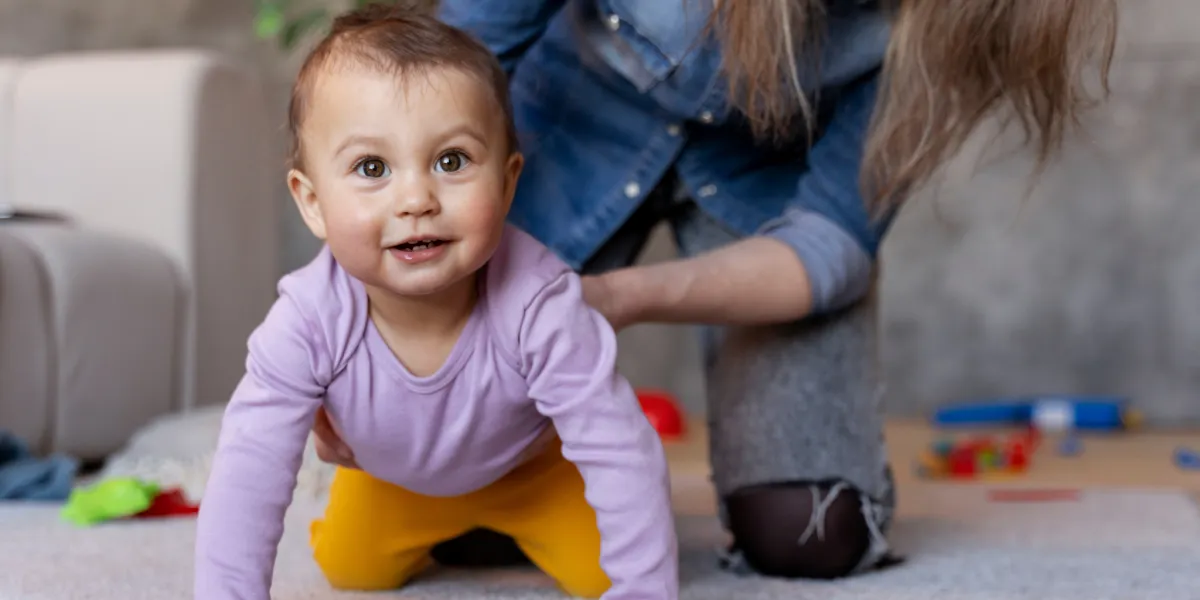
Promoting Physical Development in Infants
Something you would have noticed now if you have an infant is that babies grow fast. From when they curled-up as newborns to crawling, standing, and even taking steps—all happening within a year. In infants, physical development is not just about movement of the limbs. It’s about building strength, coordination, and confidence in themselves.
As a pediatrician, I often walk parents through this stage. And as a parent, I’ve been through it myself—right in the middle of the living room floor with a crying baby who hated tummy time.
Yes, my youngest wanted nothing to do with being on her belly. The moment I placed her down, she would become very fussy. Sometimes she’d scream as if she had a bad bite. But I knew how important it was for her to have tummy time, so I had to get creative—and be patient.
Here’s what I’ve learned from both sides of the exam table.
Why Physical Development Matters
Supporting your baby through physical development activities helps babies build the muscles and coordination they need to:
Hold their head up
Roll, sit, crawl, stand
Reach, grasp, and explore
It also supports brain growth. Physical development helps babies learn about space, balance, and cause and effect. When they reach for a toy or roll to grab something, they’re not just moving—they’re also thinking and learning about their environment.
How to Promote Physical Development
In general, you don’t need fancy tools or programs. You just need time, space, and attention. Here’s what works:
1. Start Tummy Time Early—and Keep Going
Tummy time strengthens the neck, shoulders, arms, and back. It helps babies learn to push up, roll, and crawl.
You can start with a few minutes, 2–3 times a day, right after birth. Place your baby on a firm, safe surface while they’re awake and alert.
If your baby hates it (like mine did), try:
Laying them on your chest while you recline
Using a rolled towel under the chest
Placing a mirror or favorite toy in front of them
Getting down on the floor with them also helps. Yes, it's a fun thing for me to do.
I advise you to keep it short at first especially if your baby doesn’t like it. Even 1–2 minutes counts. Over time, you should increase the duration as they get more used to it and get stronger.
🔬 Myth vs. Medicine Spotlight: What Research Says
🧠 Myth: Tummy time is optional and doesn’t significantly impact development
Some parents believe that tummy time is merely a suggestion and not crucial for their baby’s development. However, research shows tummy time has significant and measurable benefits for motor development.
📚 Key Study #1
A 2020 systematic review published in Pediatrics analyzed 16 studies and found that tummy time is positively associated with improved gross motor skills in infants—including better head control, rolling, crawling, and sitting. It also found associations with lower risk of brachycephaly (flat head syndrome) and healthier weight gain.
In short, this study shows that tummy time is not optional. It’s essential for strengthening muscles that support movement and posture. These benefits build a foundation for future developmental milestones.
📖 Key Study #2
Another 2020 study from the Journal of Applied Behavior Analysis looked at strategies to make tummy time more tolerable. Researchers tested ways to reduce crying and resistance in babies who disliked tummy time. The most effective methods included using a parent’s chest, interactive toys, and caregiver engagement during the activity.
This research confirms what many parents already sense—babies often resist tummy time, but with support, they adjust. And it’s worth it. These interventions helped babies stay in tummy time longer and improved tolerance over time.
🩺 Pediatrician Insight
As both a pediatrician and a parent, I’ve seen tummy time work—once we get through the initial protests. When done consistently, even with just a few minutes a day, babies get stronger and more coordinated. The research backs up what I tell families in my clinic every day: it doesn’t have to be perfect, it just has to be consistent.
2. Encourage Reaching and Grabbing
Place toys just out of reach during playtime. This encourages stretching, scooting, and rolling. You can also offer different textures and sizes to help with grip strength and fine motor skills. Soft balls, teething rings, and textured clothes all work well. Make your baby explore their hands and feet. It may not look like much, but it builds awareness and control.
3. Give Space to Move
Do this by limiting the time in swings, bouncers, and seats. These items can be helpful in moderation especially when you cannot keep at sight, but babies need floor time to move freely.
Use a clean, safe play mat or blanket on the floor. Let your baby kick, roll, and move at their own pace.
4. Help Them Practice Sitting and Standing
At around 4–6 months, help your baby sit by supporting them with pillows or your hands. But by about 6–9 months, many of them can sit without help.
You can hold them while they stand on your lap or at a low surface. This strengthens their legs and helps them feel balance.
AAP does not recommend walkers, so avoid walkers—they don’t help babies walk faster and can be unsafe as they can fall on these walkers. Some parents use stationary activity centers and that is ok if used in short sessions.
5. Make Movement Fun and Encourage them to move
Sing songs with actions (“Itsy Bitsy Spider,” “Head, Shoulders, Knees, and Toes” are some of the common examples of rhythms that babies like). Gently move your baby’s arms and legs along with the rhythm as you sing them.
Cheer them on when they move. Smile and laugh at them when they move. Celebrate their little wins—either lifting their head, rolling over, reaching a toy, it's all a win.
Babies too love encouragement as we adults do. It builds confidence in them and motivates them to keep trying.
Be Patient—Every Baby Develops at Their Own Pace
Some babies roll early. Others crawl late. Some skip crawling altogether and go straight to walking. That’s okay.
The key is steady progress—not hitting exact dates. If your baby isn’t meeting expected milestones, or if they seem very floppy or stiff, check in with your pediatrician. Early support can make a big difference.
As I said previously about my youngest child, tummy time felt like a battle but we stayed consistent. Eventually, she got stronger. She rolled, sat, and crawled. And what about the initial tears? They faded.
So sometimes, development is loud and sometimes it’s quiet. But it’s always happening, even in its quietness.
You’re Not Alone
Helping your baby grow strong can feel like a mix of wonder and worry. If you ever have questions—about what’s normal, what’s not, or how to support your baby’s movement—we’re here.
As a pediatrician and as a parent who’s been there, I can help you track your baby’s progress and build healthy habits that promote their physical development from the start.
🔎 References
Lyndel Hewitt, Erin Kerr, Rebecca M. Stanley, Anthony D. Okely; Tummy Time and Infant Health Outcomes: A Systematic Review. Pediatrics June 2020; 145 (6): e20192168. 10.1542/peds.2019-2168
Mendres-Smith AE, Borrero JC, Castillo MI, et al. Tummy time without the tears: The impact of parent positioning and play. J Appl Behav Anal. 2020;53(4):2090–2107. doi:10.1002/jaba.691
